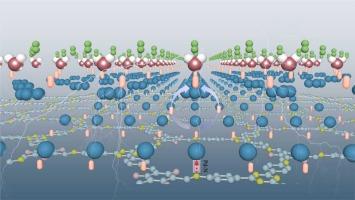Pd单原子与纳米级Pd原子团簇之间的协同效应:促进Pd- n电荷通道的形成和大规模光催化析氢的强内部电场
IF 17.1
1区 材料科学
Q1 CHEMISTRY, PHYSICAL
引用次数: 0
摘要
单原子(SAs)和纳米级原子团簇(ACs)催化剂因其优异的选择性和丰富的活性位点而受到广泛关注。在本研究中,采用化学还原方法成功地将Pd、Au和Pt元素锚定在COF (Tatp)上。值得注意的是,负载Pd的Tatp具有优异的析氢性能。利用交流- stem和同步辐射技术,我们证明了Pd sa和Pd ACs在Tatp上共存(Pd sa -ACs)。结合DFT计算,我们已经证明了电子离域Pd - sa和亚胺键内电子定域N原子之间的强相互作用。这种相互作用促进了Pd-N电子传递通道的建立。Pd - ACs的掺入为光催化反应引入了许多活性位点,同时自发地产生强大的内部电场(IEF)。Pd - sa和Pd - ac之间的协同作用不仅大大缩短了电荷转移距离,而且为光生电子的高效分离和迁移提供了充足的动力。我们利用PdTatp3进行了平方米尺度的析氢实验,在10 h内产氢量达到22.96 mmol。本研究为利用sa和纳米级ac的协同效应来提高光催化析氢性能提供了一个有希望的策略。本文章由计算机程序翻译,如有差异,请以英文原文为准。

Synergistic Effects Between Pd Single Atoms and Nanoscopic Pd Atom Clusters: Facilitating Formation of Pd-N Charge Channels and Strong Internal Electric Fields for Large-scale Photocatalytic Hydrogen Evolution
Single atoms (SAs) and nanoscale atom clusters (ACs) catalysts have garnered significant attention owing to their exceptional selectivity and abundant active sites. In this study, a chemical reduction method was employed to successfully anchor Pd, Au, and Pt elements onto COF (Tatp). Notably, the Tatp loaded with Pd exhibits superior hydrogen evolution performance. Utilizing AC-STEM and synchrotron radiation techniques, we demonstrate the coexistence of Pd SAs and Pd ACs on the Tatp (Pd SAs-ACs). Combined with DFT calculations, we have demonstrated a strong interaction between the electron-delocalized Pd SAs and the electron-localized N atoms within the imine bond. This interaction facilitates the establishment of the Pd-N electron transport channel. The incorporation of Pd ACs introduces numerous active sites for photocatalytic reactions while spontaneously generating a strong internal electric field (IEF). The synergistic interplay between Pd SAs and Pd ACs not only significantly reduces the charge transfer distance but also provides ample driving force for the efficient separation and migration of photogenerated electrons. We employed PdTatp3 for the square-meter-scale hydrogen evolution test, and the hydrogen production volume reached 22.96 mmol over a period of 10 h. This study proposes a promising strategy for harnessing the synergistic effect of SAs and nanoscale ACs to enhance photocatalytic hydrogen evolution performance.
求助全文
通过发布文献求助,成功后即可免费获取论文全文。
去求助
来源期刊

Nano Energy
CHEMISTRY, PHYSICAL-NANOSCIENCE & NANOTECHNOLOGY
CiteScore
30.30
自引率
7.40%
发文量
1207
审稿时长
23 days
期刊介绍:
Nano Energy is a multidisciplinary, rapid-publication forum of original peer-reviewed contributions on the science and engineering of nanomaterials and nanodevices used in all forms of energy harvesting, conversion, storage, utilization and policy. Through its mixture of articles, reviews, communications, research news, and information on key developments, Nano Energy provides a comprehensive coverage of this exciting and dynamic field which joins nanoscience and nanotechnology with energy science. The journal is relevant to all those who are interested in nanomaterials solutions to the energy problem.
Nano Energy publishes original experimental and theoretical research on all aspects of energy-related research which utilizes nanomaterials and nanotechnology. Manuscripts of four types are considered: review articles which inform readers of the latest research and advances in energy science; rapid communications which feature exciting research breakthroughs in the field; full-length articles which report comprehensive research developments; and news and opinions which comment on topical issues or express views on the developments in related fields.
 求助内容:
求助内容: 应助结果提醒方式:
应助结果提醒方式:


